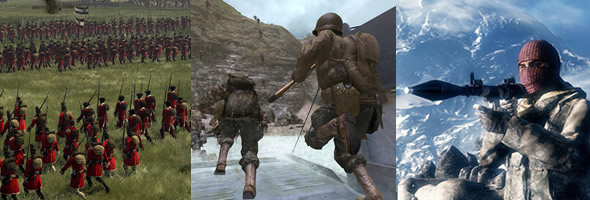
The history of modern warfare is one of evolving technologies, from the earliest crude muskets to the most advanced missile defense systems. 4GW is the untold story of the fourth generation of war, one where networks have become battlegrounds, civilians have become soldiers, and information has become the ultimate weapon.
It all starts with a video game: “4G War” the latest blockbuster title in a growing $15 billion industry. Unlike any of its predecessors, 4GW represents the convergence of two incredibly successful genres that have each pushed gaming hardware and software to their limits.
Massively Multiplayer online gaming (MMORPG) has been around for nearly a decade, hosting thousands of players from around the planet under the unifying physics of alien planets or Medieval myth and magic. These games have flourished over the last decade as Internet access expanded worldwide, and now host millions of players simultaneously across a variety of virtual worlds. In contrast, First-Person Shooters (FPS) have focused on perfecting the single-user experience, with hyper-realisticcombat simulations driven by the latest graphics hardware. Their weaponry and tactics have become so authentic that various branches of the military regularly use them for recruiting and training, and they often gross more than blockbuster Hollywood films.
4GW is the first attempt to blend both of these popular genres into an entirely new gaming experience. As the game’s lead designer is quick to point out: “Modern simulators are obsolete. Their battlefields and tactics are stale and outdated. Today’s gameplayers want to solve complex, multi-dimensional problems. They want to experience the rush of flexible, asymmetrical combat. And they want their social networks to drive that experience. So unlike bulky artificial intelligence, every major character in a 4GW battle is played by an actual human being, adding a level of military realism previously unimaginable. Kids in Kansas can hop online and run massive military campaigns against schoolteachers in San Diego, judges in Japan and bank managers in Beirut.”
On the flip side, as millions of players from around the world wage war for multi-million dollar tournament prizes, their movements and tactics have instantly become the world’s largest database of military strategy . Within the flexibility and realism of the 4GW ecosystem, these amateur warriors discover brilliant and unconventional ways to attack and defend, using tactics that fly in the face of even the most sophisticated combat training. For traditional superpowers like the U.S., studying these unconventional strategies can provide critical combat insights at a fraction of the cost of live military exercises. For rising powers and rogue armies, access to this type of strategic intelligence was previously unimaginable, and they will stop at nothing to steal the tournament data and try to level the global battlefield.
